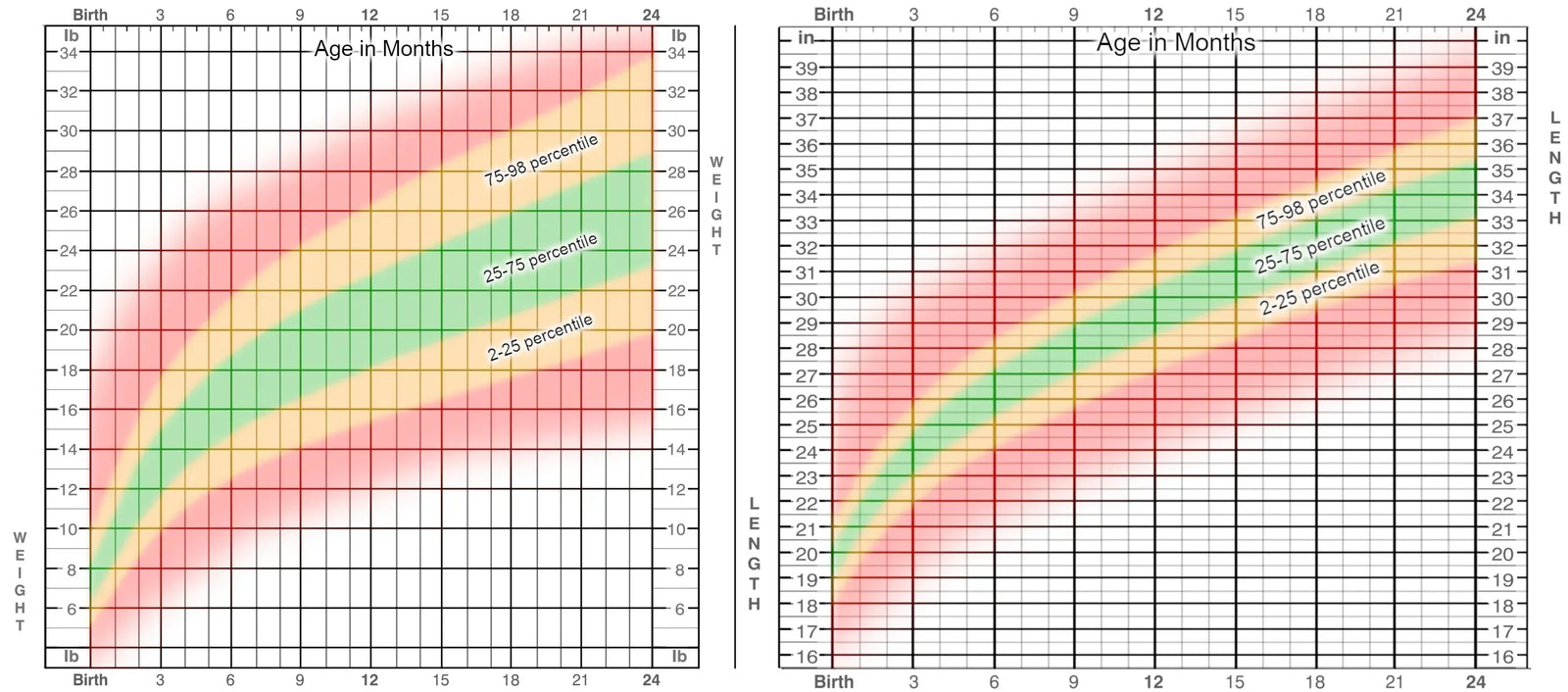As a parent who's been through the early years, I know how easy it is to worry about your child’s size.
You hear other babies are “big for their age,” or someone says your toddler looks “small”, and suddenly you’re wondering if everything’s okay.
This guide is here to give you straightforward, fact-based information on what’s normal for babies and toddlers — from birth all the way to age 5.
You’ll find:
- Average weight and height ranges by age
- What’s different between boys and girls
- How growth really works (and when to worry — or not)
- A simple reminder of what helps your child grow strong and healthy
Let’s clear up the confusion — so you can focus less on charts and more on enjoying these early years.
Weight & Height Ranges by Baby's Age
Below are typical weight and height ranges from birth to age 5. These aren’t goals or pass/fail numbers — they’re broad averages. It’s perfectly normal for your child to fall near the lower or upper end, or even just outside these ranges, as long as they’re growing steadily over time.
| Age | Weight Range (lb) | Height Range (in) |
|---|---|---|
| 0–3 mo | 8.8–14.3 lb | 21.2–24 in |
| 4–6 mo | 13.2–18.7 lb | 24–26.4 in |
| 7–12 mo | 16.5–23 lb | 26.4–30.3 in |
| 1 year | 19.8–25.4 lb | 28.3–32.3 in |
| 2 years | 23–30 lb | 32.7–36.2 in |
| 3 years | 26–35 lb | 35.5–39.4 in |
| 4 years | 28.6–39.7 lb | 37.4–41.3 in |
| 5 years | 33–44 lb | 39.4–44 in |
📌 Boys vs. Girls: Boys tend to be slightly heavier and taller than girls at the same age. Differences are small and more visible over time — not something to worry about in isolation.
How Pediatricians Assess Growth
Doctors don’t expect your child to match an “average” weight or height — they care more about how your child is growing over time.
They use growth charts to track progress at each check-up. These charts show percentiles — for example, if your child is in the 30th percentile for height, that means 30% of children their age are shorter, and 70% are taller. It’s just a way to see how they compare — not a grade or score.
At home, a baby scale can help you keep an eye on your baby's weight and height between doctor appointments.
What matters most:
- Your child is following a steady curve, not suddenly increasing or dropping in weight
- Their height and weight stay proportionate
- They’re meeting other development milestones
So if your child is on the smaller (or bigger) side but has always been that way — and is healthy, active, and thriving — chances are, everything is just fine.
What Supports Healthy Growth of Your Baby?
There’s no secret trick — your infant's healthy growth comes down to a few consistent elements. These basics matter more than percentiles or comparisons.
✅ Good nutrition
- Newborns (0–4 months): Breast milk or formula is all they need.
- Babies 4–6 months old: Slowly introduce flavors — those first spoonfuls aren’t just about filling tiny tummies—they’re about gentle exploration (find some recipe ideas for this age phase here)
- Babies 6–12 months old: Slowly introduce solids — focus on iron-rich foods, soft fruits, veggies, grains, and protein.
- Toddlers and preschoolers: Offer a variety — whole foods, not perfection. Think fruit, veg, grains, eggs, dairy, fish, beans, healthy fats.
💡 To make preparing fresh, healthy meals easier, many parents find a baby food maker with blending really handy — it’s a simple way to control ingredients and textures as your little one starts solids.
💡 Picky eating is common among toddlers. Keep offering a variety of foods without putting much pressure on the child.
✅ Enough sleep
- Growth hormones are active during sleep.
- Most toddlers need 11–14 hours in 24 hours, including naps.
✅ Daily movement
- Crawling, climbing, walking, running — the fact that your baby is active supports healthy bone and muscle growth.
- Free play is more valuable than structured exercise at this age.
✅ A secure, loving environment
- Emotional safety helps with baby's physical development, too.
- Connection, cuddles, routines — they all play a role in healthy growth.
Bottom line: Healthy kids come in all sizes. Feed them well, let them move and rest, and keep an eye on the big picture. Growth will follow.
Final Note: Trust the Trend, Not a Single Number
Every child grows at their own pace — what matters most is that your little one is growing steadily and healthily over time. Don’t stress if they fall on the smaller or bigger side of the average; growth charts are just tools, not rules.
Focus on good nutrition, plenty of movement, and lots of love — these are the real keys to your baby's healthy development. And whenever you feel unsure, your pediatrician is there to help guide you.
Remember: you know your child best. Trust yourself, and enjoy watching them grow.
Further trustworthy sources, if you still have questions: who.int, cdc.gov, medlineplus.gov

